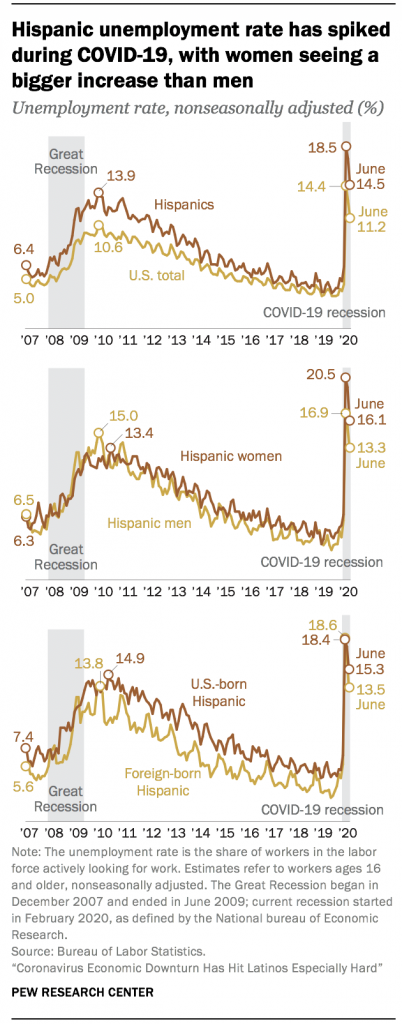COVID-19 has taken the lives of a disproportionate amount of Hispanics-Latinos in Connecticut and across the United States.
The Centers for Disease Control and Prevention paints a grim picture when it comes to the Hispanic population in the pandemic. Nationally, the CDC reported, 28% of those who have contracted COVID-19 are Hispanic-Latino, though they make up about 18% of the U.S. population.
The coronavirus outbreak has significantly harmed the finances of U.S. Hispanics-Latinos. As the nation’s economy contracted at a record rate in recent months, the group’s unemployment rate rose sharply, particularly among Hispanic-Latinas, and remains higher among Hispanic-Latino workers than U.S. workers overall, according to a report by the Pew Research Center. With Hispanic-Latino households absorbing lost jobs and wages, many have said they may not be able to pay their bills. Yet even before the outbreak, Hispanics-Latinos were concerned about their economic situation despite near-record-low levels of unemployment through the end of 2019.

For Americans 60 and older, COVID-19 is widespread and deadly. Its economic impact could also be devastating, according to research by Marc Cohen, University of Massachusetts Boston, and Jane Tavares, University of Massachusetts Boston.
Given the pervasiveness of systemic racism in the U.S., it’s not surprising that older Blacks and older Hispanics-Latinos suffered the deepest financial declines during the 2008 recession.
In a conversation on ctpost, Cohen and Tavares share that older Hispanics-Latinos had almost twice the number of losses in net total wealth than non-Hispanic whites. They also had the highest increase in poverty, a 5.5 percentage point jump, more than any other demographic group.
The findings paint a grim picture of what may come from the pandemic: a recession likely to have a far greater impact than the 2008-09 downturn, especially on people of color older (POC) adults. Given that the unemployment rate among older POC Americans is already disproportionately high and that many have health conditions that make it difficult to work, their ability to change their financial situation is small compared to other groups.
As the United States locked down amid COVID-19, the unemployment rate for Hispanics-Latinos increased from 4.8% in February to a peak of 18.5% in April before dropping to 14.5% in June, nonseasonally adjusted. This exceeds levels from the Great Recession of 2007-2009, when the unemployment rate peaked at 13.9% in January 2010. Hispanic-Latina women have experienced an especially steep rise in their unemployment rate, which jumped from 5.5% to 20.5% between February and April 2020. By comparison, the unemployment rate for Hispanic-Latino men rose from 4.3% to 16.9% during this time. In June, the unemployment rate of U.S.-born Hispanics-Latinos (15.3%) was higher than that of foreign-born Hispanics-Latinos (13.5%), after the rates for both groups peaked at more than 18% in April.
While Hispanic-Latino residents make up 16.5% of Connecticut’s overall population, they only account for 7% of the roughly 25,000 people living in Connecticut’s nursing homes on any given day.
With an average age of 29 compared to 47 for whites, Hispanic-Latino residents are collectively the state’s youngest population and for that and other reasons, there are fewer of them in nursing homes. U.S. Census figures show only about 5.9-percent of residents of nursing homes and assisted living facilities are Hispanic-Latino, slightly less than the state’s 7-percent.
According to the Administration on Aging, U.S. Department of Health and Human Services: the population of Americans age 65 and older is expected to grow rapidly in the coming decades. The Hispanic-Latino population, in particular, is expected to make up an increasing proportion of those aged 65 and older in the coming years reports the U.S. Census Bureau.
CTLatinoNews.com (CTLN) partners with AARP Connecticut in best serving Hispanic-Latino residents in Connecticut. AARP CT has a local jobs portal to help seekers find new employment opportunities, and get career advice.




